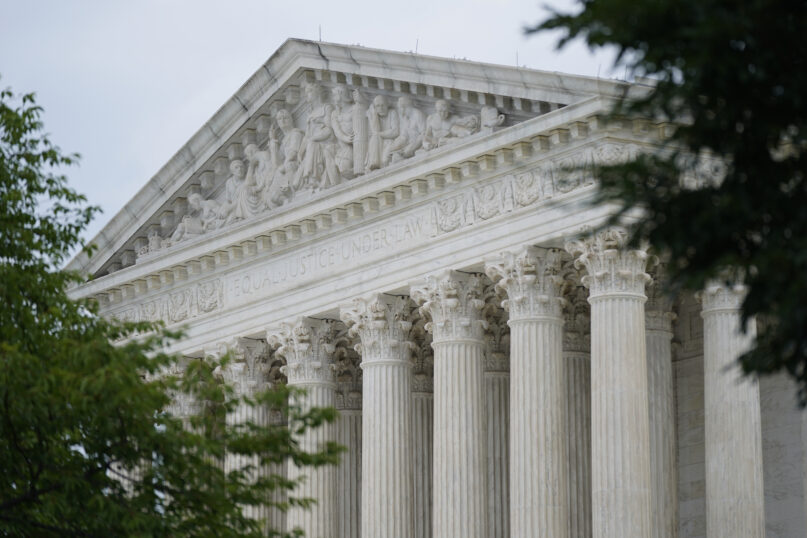(RNS) — The U.S. Supreme Court term that ended Friday (June 30) proved what I learned in a political science course more than 50 years ago: The U.S. Constitution is what five or more of the nine justices say it is.
I am not saying that legal theory does not matter, but cases that get to the Supreme Court are complicated and controversial. If they were easy, they would have been settled by a lower court. That leaves the court with a lot of discretion.
The case involving affirmative action at Harvard University and the University of North Carolina is revelatory. The court majority argued that the equal protection clause of the Constitution’s 14th Amendment outlaws discrimination based on race, and therefore, schools cannot make race a deciding factor in admissions.
This interpretation looks only at the text of the 14th Amendment and ignores the history behind it. It is outrageous that an amendment that was intended to protect freed slaves is now being used to outlaw attempts to help their descendants who are still enduring the legacy of slavery and discrimination.
We know from the experience of California, Michigan and Florida, where affirmative action was already outlawed, that the immediate impact will be to reduce the percentage of Black, Latino and Native American students in elite public and private schools. This will have long-term financial impacts on these students. It will also make these schools even less reflective of America as a whole.
One of the cases resolved in the Supreme Court’s ruling was brought by students of Asian heritage, who said Harvard University’s admissions discriminated against them. Their complaint deserves attention, but the reality is that the Harvard case was funded by a white conservative activist, Edward Blum, who regularly challenges affirmative action policies and voting rights laws.
Such conservative activists seem to have no problem with legacy admissions, in which the sons and daughters of alums, who are overwhelmingly white, are given preference. Nor did the court’s ruling bar children and grandchildren of white alums from benefitting from historical discrimination — though it may have its chance; a civil rights group filed a complaint Monday (July 3) contesting the practice of legacy admissions, based on data turned over in the affirmative action case.
Although the court has banned affirmative action based on race, schools should not give up. Diversity can be achieved by giving preference to students from low-income families, to children who are the first in their families to go to college, and to the top graduates from non-elite high schools. An argument could be made that these approaches might provide a more diverse student body than one that is made up of a racially diverse group of rich kids.
The court also said that schools can give more consideration to student essays, though this would likely only mean giving high school counselors and chatbots more important roles in the admissions process.
Catholic colleges and universities bemoaned the court’s decision because they consider serving marginalized groups part of their Catholic mission. It would be wonderful if they went to court to argue that banning their use of affirmative action is a violation of their religious freedom. Granted the court’s willingness to strongly affirm religious freedom, it would be fun to see how the court would rule in such a case.
Speaking of religious freedom, the justices also affirmed that the state of Colorado could not force Lorie Smith, a web designer, to produce websites for gay couples’ marriages. The decision was based more on free speech than religious freedom, but both played a role.
I find this case, like the earlier case dealing with a Colorado cake baker, disconcerting. As a Catholic, this is a no-brainer. Catholics can with clear consciences provide wedding cakes, websites, flowers, catering and other services to a gay wedding even though the church opposes such weddings. Catholic judges can perform gay marriages, just as they can preside over divorce cases; Catholic clerks can provide marriage licenses to gay couples.
For the Catholic bishops to celebrate this as a big win for religious freedom is silly. This is a case we should have stayed away from as long as Catholic institutions are not compelled to provide such services.
On the other hand, my respect for freedom of conscience makes me sympathetic to the baker and web designer. I may believe they are wrong, but I want to respect their right to their beliefs, especially since they are willing to provide non-wedding services to gay customers.
These kinds of cases make me suspect that they are more about fundraising and legal fees on both sides than about reality. Both the baker and the web designer were willing to serve gay customers for non-wedding services. Do gay couples really want homophobes to design their wedding cakes and websites? Were these fights worth waging? Do they not hurt gay rights in the court of public opinion?
Granted the current makeup of the court, Colorado could have saved itself time and money by simply changing the law to include a narrow religious exemption for those who are willing to serve gay people but not use their creative talents to support their weddings. Taking such cases to the current Supreme Court, where the decisions might have uncertain consequences, is dangerous. We hope that the web case will be interpreted narrowly by the lower courts and have little impact, but we will have to wait and see.
Finally, there is the court’s decision declaring that President Biden and the Department of Education exceeded their authority by forgiving an estimated $400 billion in student loans. Student debt is huge and forces borrowers to postpone marriage, children and buying homes. On the other hand, they get no sympathy from those who paid off their student loans or from those who did not go to college.
The saddest cases are those students who went to for-profit institutions that promised them high-paying jobs but only gave them inferior courses and debts. Those running these scams belong in jail.
But also guilty are traditional colleges and universities that have raised their tuition so fast and so high that it is almost impossible to graduate without debt. This is unsustainable. Technology and a falling birthrate demand a revolution in higher education, and those institutions that do not change will not survive.
In any case, generous debt forgiveness should be provided to those who join the armed services, teach in poor schools or work in the government when they could make much more in the private sector. More direct aid current students is also needed.
Republicans are cheering the court’s decision on student forgiveness, but they may find that, as with the Dobbs decision, which returned to the states the right to make laws about abortion, the student loan case may prove politically damaging. Tens of millions of young voters will have to resume paying off their student debts in the coming months, right before the 2024 election. No one will vote Republican because of this decision, but millions of debtors when they go to the polls will remember which party wanted to help them and which did not.
If the Constitution is what five Supreme Court justices say it is, who controls the presidency and the Senate, which determine who goes on the court, really matters. The Roberts court has made this clear even though that was not their intent.






